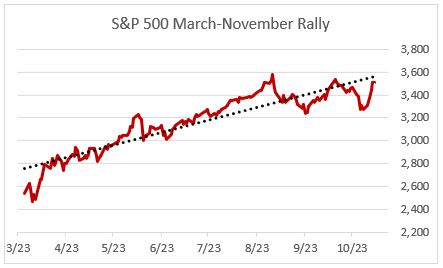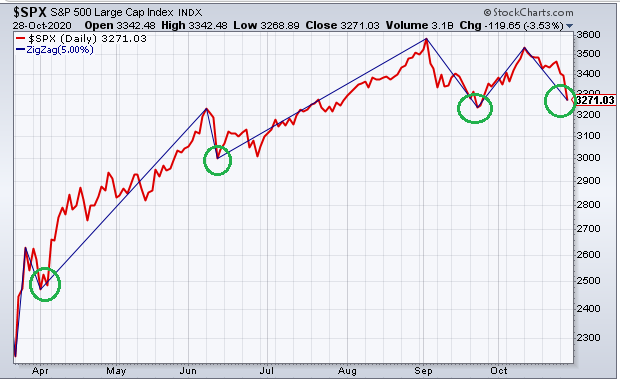Are we in a new Bull Market
Last week was the 29th best week for the market since 1950, so it was a big deal. How good was last week's rally? Better than 99% of all weeks in the last 70 years. Here are the numbers.
3565 total weeks since 1950
2100 up weeks
1592 down weeks
4 flat weeks
Up weeks:
Median 1.17%
Average 1.49%
Down weeks:
Median-1.19%
Average-1.58%
Last week:
Up 7.32%
What caused it?
Why is the market going up in the middle of a worsening pandemic? Why is it going up in the middle of a contested election? Why is it going up during a deep recession?
The market is going up because investors believe that the FED and Congress will provide as much stimulus as necessary to help us climb out of the hole we find ourselves in today. And they believe that corporate earnings will return to pre-pandemic levels by mid-2021. Are they right, or have they miscalculated?
Are we in a new bull market? Or are we in a rally inside of a longer bear market? As Ralph Wanger, manager of the ultra-successful Oakmark Acorn Fund was fond of saying, "The only thing faster than the speed of light is a rally in a bear market."
First, let's define some terms.
What is a Bull Market?
What is a Bull Market?
Courtesy of Investopedia
A bull market is one in which prices are rising consistently and continuously for an extended period. Because prices of securities rise and fall continuously during trading, the term "bull market" is typically reserved for extended periods in which a large portion of security prices are rising. Bull markets tend to last for months or even years.
Understanding Bull Markets
Bull markets are characterized by investor optimism, confidence, and expectations that rising prices will continue for an extended period of time. It is difficult to predict consistently when the trends in the market might change.
Perhaps the most common definition of a bull market is a situation in which stock prices rise by 20%, usually after a bear market drop of 20% or more. Since bull markets are difficult to predict, analysts can typically only recognize this phenomenon after it has happened.
Characteristics of a Bull Market
Bull markets generally take place when the economy is strengthening or when it is already strong. They tend to happen in line with strong gross domestic product (GDP) and a drop in unemployment and will often coincide with a rise in corporate profits.
Investor confidence will also tend to climb throughout a bull market period. The overall demand for stocks will be positive, along with the overall tone of the market. In addition, there will be a general increase in the amount of IPO activity during bull markets.
Notably, some of the factors above are more easily quantifiable than others. While corporate profits and unemployment are quantifiable, it can be more difficult to gauge the general tone of market commentary, for instance.
Market Mentalities: Bulls Vs. Bears
The opposite of a bull market is a bear market, which is characterized by falling prices and typically shrouded in pessimism. The commonly held belief about the origin of these terms suggests that the use of "bull" and "bear" to describe markets comes from the way the animals attack their opponents. A bull thrusts its horns up into the air, while a bear swipes its paws downward. These actions are metaphors for the movement of a market. If the trend is up, it's a bull market. If the trend is down, it's a bear market.
Bull and bear markets often coincide with the economic cycle, which consists of four phases: expansion, peak, contraction, and trough. The onset of a bull market is often a leading indicator of economic expansion. Because public sentiment about future economic conditions drives stock prices, the market frequently rises even before broader economic measures, such as gross domestic product (GDP) growth, begin to tick up.
Likewise, bear markets usually set in before economic contraction takes hold. A lookback at a typical U.S. recession reveals a falling stock market several months ahead of GDP decline.
How close we are to market trend.
Will we ever revisit the March 23rd low of 2236?
In order for the market to drop to the March 23rd low of 2236 it would require a 36% decline from last Friday's closing price of 3509. Could that happen? Sure. It's happened many times throughout history.
Will it happen? Historically, the odds aren't good.
Where we are YTD on the S&P 500
The chart below shows where we are in the S&P 500 as of today. On the left we see periodic returns for various time frames. On the right we see the distance from key markers.
After a stellar week, the market is up by 8.6% YTD. And its up by 14.1% year-over-year after being up 38% before the pandemic struck. Things are looking rosy.
Will the bulls make a new high?
The chart below shows that the dip-buyers have only allowed four declines of 5% or greater since the recent bottom in March 2020. And they showed up once again in November.
Don't underestimate the dip-buyers. Mostly retail types, they have been in control of this market since March 23rd. They have the Powell Fed on their side. And there seems to be no limit to the amount of risk they are willing to take.
Final thoughts
My view is that the short-term market direction is higher. I also think that the amount of upside is limited by stretched valuations, a worsening pandemic, a contested election, an ongoing recession, and a lack of needed stimulus from our leaders in congress.
I can see a new high, or a series of new highs, punctuated by large down days or weeks as we work our way through these barriers. What I don't see is a return to the March low point. Worst case scenario would be 2500-2700 on the S&P 500.
That would be a big drop from here, which is why I'm keeping cash levels higher than usual and a short position via the SH ETF.



